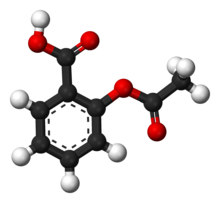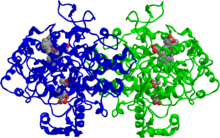- Mechanism of action of aspirin
-
Aspirin causes several different effects in the body, mainly the reduction of inflammation, analgesia (relief of pain), the prevention of clotting, and the reduction of fever. Much of this is believed to be due to decreased production of prostaglandins and thromboxanes. Aspirin's ability to suppress the production of prostaglandins and thromboxanes is due to its irreversible inactivation of the cyclooxygenase (COX) enzyme. Cyclooxygenase is required for prostaglandin and thromboxane synthesis. Aspirin acts as an acetylating agent where an acetyl group is covalently attached to a serine residue in the active site of the COX enzyme. This makes aspirin different from other NSAIDs (such as diclofenac and ibuprofen), which are reversible inhibitors. However, other effects of aspirin, such as uncoupling oxidative phosphorylation in mitochondria, and the modulation of signaling through NF-κB, are also being investigated.
Contents
History of discovery
See also: History of aspirinThe mechanism of aspirin's analgesic, anti-inflammatory and antipyretic properties was unknown through the drug's heyday in the early- to mid-twentieth century; Heinrich Dreser's explanation, widely accepted since the drug was first brought to market, was that aspirin relieved pain by acting on the central nervous system. In 1958 Harry Collier, a biochemist in the London laboratory of pharmaceutical company Parke Davis, began investigating the relationship between kinins and the effects of aspirin. In tests on guinea pigs, Collier found that aspirin, if given beforehand, inhibited the bronchoconstriction effects of bradykinin. He found that cutting the guinea pigs' vagus nerve did not affect the action of bradykinin or the inhibitory effect of aspirin—evidence that aspirin worked locally to combat pain and inflammation, rather than on the central nervous system. In 1963, Collier began working with University of London pharmacology graduate student Priscilla Piper to determine the precise mechanism of aspirin's effects. However, it was difficult to pin down the precise biochemical goings-on in live research animals, and in vitro tests on removed animal tissues did not behave like in vivo tests.[1]
After five years of collaboration, Collier arranged for Piper to work with pharmacologist John Vane at the Royal College of Surgeons of England, in order to learn Vane's new bioassay methods, which seemed like a possible solution to the in vitro testing failures. Vane and Piper tested the biochemical cascade associated with anaphylactic shock (in extracts from guinea pig lungs, applied to tissue from rabbit aortas). They found that aspirin inhibited the release of an unidentified chemical generated by guinea pig lungs, a chemical that caused rabbit tissue to contract. By 1971, Vane identified the chemical (which they called "rabbit-aorta contracting substance," or RCS) as a prostaglandin. In a June 23, 1971 paper in the journal Nature,[2] Vane and Piper suggested that aspirin and similar drugs (the non-steroidal anti-inflammatory drugs or NSAIDs) worked by blocking the production of prostaglandins. For this discovery, Vane was awarded both a Nobel Prize in Physiology or Medicine in 1982 and a knighthood. Later research showed that NSAIDs such as aspirin worked by inhibiting cyclooxygenase, the enzyme responsible for converting arachidonic acid into a prostaglandin.[3]
Effects on cyclooxygenase
See also: CyclooxygenaseThere are at least two (and possibly three[4]) different cyclooxygenase isozymes: COX-1 and COX-2. Aspirin is non-selective and irreversibly inhibits both forms.[5] Normally COX produces prostaglandins, most of which are pro-inflammatory, and thromboxanes, which promote clotting. Aspirin-modified COX-2 produces lipoxins, most of which are anti-inflammatory. Newer NSAID drugs called COX-2 selective inhibitors have been developed that inhibit only COX-2, with the hope for reduction of gastrointestinal side-effects.[4]
However, several of the new COX-2 selective inhibitors have been recently withdrawn (see Vioxx), after evidence emerged that COX-2 inhibitors increase the risk of heart attack. It is proposed that endothelial cells lining the microvasculature in the body express COX-2, and, by selectively inhibiting COX-2, prostaglandins (specifically PGI2; prostacyclin) are downregulated with respect to thromboxane levels, as COX-1 in platelets is unaffected. Thus, the protective anti-coagulative effect of PGI2 is decreased, increasing the risk of thrombus and associated heart attacks and other circulatory problems. Since platelets have no DNA, they are unable to synthesize new COX once aspirin has irreversibly inhibited the enzyme, an important difference with reversible inhibitors.
Effects on prostaglandins and thromboxanes
See also: Prostaglandins and ThromboxanesAspirin's ability to suppress the production of prostaglandins and thromboxanes is due to its irreversible inactivation of the cyclooxygenase (COX) enzyme. Cyclooxygenase is required for prostaglandin and thromboxane synthesis. Aspirin acts as an acetylating agent where an acetyl group is covalently attached to a serine residue in the active site of the COX enzyme. This makes aspirin different from other NSAIDs (such as diclofenac and ibuprofen), which are reversible inhibitors.
Low-dose, long-term aspirin use irreversibly blocks the formation of thromboxane A2 in platelets, producing an inhibitory effect on platelet aggregation. This anticoagulant property makes aspirin useful for reducing the incidence of heart attacks.[6] 40 mg of aspirin a day is able to inhibit a large proportion of maximum thromboxane A2 release provoked acutely, with the prostaglandin I2 synthesis being little affected; however, higher doses of aspirin are required to attain further inhibition.[7]
Prostaglandins are local hormones (paracrine) produced in the body and have diverse effects in the body, including but not limited to transmission of pain information to the brain, modulation of the hypothalamic thermostat, and inflammation. Thromboxanes are responsible for the aggregation of platelets that form blood clots. Heart attacks are primarily caused by blood clots, and their reduction with the introduction of small amounts of aspirin has been seen to be an effective medical intervention. The side-effect of this is that the ability of the blood in general to clot is reduced, and excessive bleeding may result from the use of aspirin.
Other methods of action
Aspirin has been shown to have three additional modes of action. It uncouples oxidative phosphorylation in cartilaginous (and hepatic) mitochondria, by diffusing from the inner membrane space as a proton carrier back into the mitochondrial matrix, where it ionizes once again to release protons.[8] In short, aspirin buffers and transports the protons. When high doses of aspirin are given, aspirin may actually cause fever due to the heat released from the electron transport chain, as opposed to the antipyretic action of aspirin seen with lower doses. Additionally, aspirin induces the formation of NO-radicals in the body, which have been shown in mice to have an independent mechanism of reducing inflammation. This reduced leukocyte adhesion, which is an important step in immune response to infection; however, there is currently insufficient evidence to show that aspirin helps to fight infection.[9] More recent data also suggests that salicylic acid and its derivatives modulate signaling through NF-κB.[10] NF-κB is a transcription factor complex that plays a central role in many biological processes, including inflammation.
Salicylate sensitivity
See also: Salicylate sensitivitySalicylate sensitivity, also known as salicylate intolerance, is any adverse effect that occurs when a normal amount of salicylate is introduced into a person's body. People with salicylate intolerance are unable to consume a normal amount of salicylate without adverse effects.
Salicylate sensitivity differs from salicylism, which occurs when an individual takes an overdose of salicylates.[11] Salicylate overdose can occur in people without salicylate sensitivity, and can be deadly if untreated. For more information, see aspirin poisoning.
Salicylates are derivatives of salicylic acid that occur naturally in plants and serve as a natural immune hormone and preservative, protecting the plants against diseases, insects, fungi, and harmful bacteria. Salicylates can also be found in many medications, perfumes and preservatives. Both natural and synthetic salicylates can cause health problems in anyone when consumed in large doses. But for those who are salicylate intolerant, even small doses of salicylate can cause adverse reactions.
Reye's syndrome
See also: Reye's syndromeReye's syndrome is a potentially fatal disease that causes numerous detrimental effects to many organs, especially the brain and liver, as well as causing hypoglycemia.[12] The exact cause is unknown, and while it has been associated with aspirin consumption by children with viral illness, it also occurs in the absence of aspirin use.
The disease causes fatty liver with minimal inflammation and severe encephalopathy (with swelling of the brain). The liver may become slightly enlarged and firm, and there is a change in the appearance of the kidneys. Jaundice is not usually present.[13]
Early diagnosis is vital; while most children recover with supportive therapy, severe brain injury or death are potential complications.
References
- ^ Jeffreys, Aspirin, pp. 223-226
- ^ Vane, J. R. (23 June 1971). "Inhibition of Prostaglandin Synthesis as a Mechanism of Action for Aspirin-like Drug". Nature 231: 232-235. http://www.nature.com/nature-newbio/journal/v231/n25/abs/newbio231232a0.html. Retrieved 16 November 2011.
- ^ Jeffreys, Aspirin, pp. 226-231
- ^ a b Cyclooxygenase-3 (COX-3): Filling in the gaps toward a COX continuum? - Warner and Mitchell 99 (21): 13371 - Proceedings of the National Academy of Sciences
- ^ Sharma S, Sharma SC (October 1997). "An update on eicosanoids and inhibitors of cyclooxygenase enzyme systems". Indian J. Exp. Biol. 35 (10): 1025–31. PMID 9475035.
- ^ [1] American Heart Association: Aspirin in Heart Attack and Stroke Prevention "The American Heart Association recommends aspirin use for patients who've had a myocardial infarction (heart attack), unstable angina, ischemic stroke (caused by blood clot) or transient ischemic attacks (TIAs or "little strokes"), if not contraindicated. This recommendation is based on sound evidence from clinical trials showing that aspirin helps prevent the recurrence of such events as heart attack, hospitalization for recurrent angina, second strokes, etc. (secondary prevention). Studies show aspirin also helps prevent these events from occurring in people at high risk (primary prevention)."
- ^ Tohgi, H; S Konno, K Tamura, B Kimura and K Kawano (1992). "Effects of low-to-high doses of aspirin on platelet aggregability and metabolites of thromboxane A2 and prostacyclin". Stroke 23 (10): 1400–1403. PMID 1412574.
- ^ Somasundaram, S. et al., S; Sigthorsson, G; Simpson, RJ; Watts, J; Jacob, M; Tavares, IA; Rafi, S; Roseth, A et al. (2000). "Uncoupling of intestinal mitochondrial oxidative phosphorylation and inhibition of cyclooxygenase are required for the development of NSAID-enteropathy in the rat". Aliment Pharmacol Ther 14 (5): 639–650. doi:10.1046/j.1365-2036.2000.00723.x. PMID 10792129. http://www.blackwell-synergy.com/doi/pdf/10.1046/j.1365-2036.2000.00723.x. Retrieved 2008-05-28.
- ^ Mark J. Paul-Clark, Thong van Cao, Niloufar Moradi-Bidhendi, Dianne Cooper, and Derek W. Gilroy 15-epi-lipoxin A4–mediated Induction of Nitric Oxide Explains How Aspirin Inhibits Acute Inflammation J. Exp. Med. 200: 69-78; published online before print as 10.1084/jem.20040566
- ^ McCarty, MF; KI Block (2006). "Preadministration of high-dose salicylates, suppressors of NF-kappaB activation, may increase the chemosensitivity of many cancers: an example of proapoptotic signal modulation therapy.". Integr Cancer Ther. 5 (3): 252–268. doi:10.1177/1534735406291499. PMID 16880431.
- ^ "salicylism" at Dorland's Medical Dictionary
- ^ "Reye syndrome" at Dorland's Medical Dictionary
- ^ Suchy, FJ, el al.; Sokol, RJ; Balistreri, WF (2007). Liver Disease in Children. Cambridge: Cambridge University Press. ISBN 0-5218-5657-4.
Categories:
Wikimedia Foundation. 2010.


